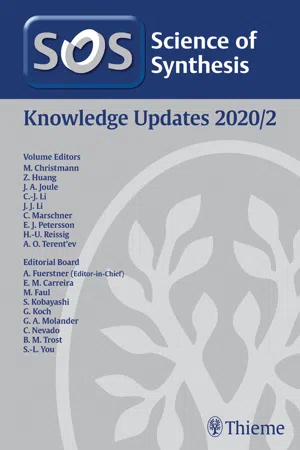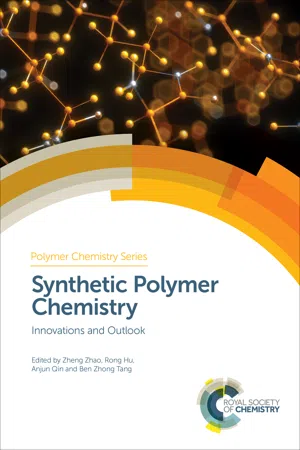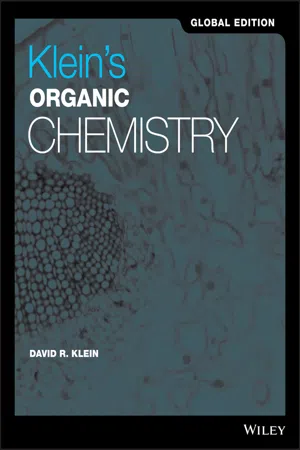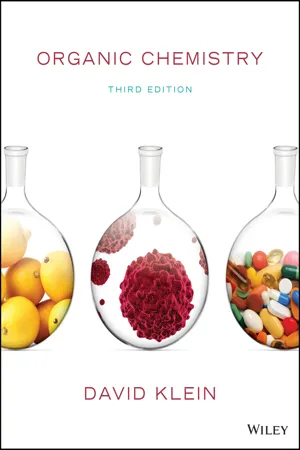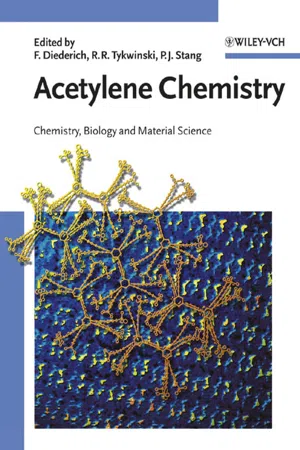Chemistry
Alkyne Synthesis
Alkyne synthesis refers to the process of creating alkynes, which are hydrocarbons containing carbon-carbon triple bonds. This can be achieved through various methods such as dehydrohalogenation of vicinal dihalides, elimination reactions of alkyl dihalides, and alkylation of acetylene. These methods allow for the formation of carbon-carbon triple bonds, expanding the range of organic compounds that can be synthesized.
Written by Perlego with AI-assistance
Related key terms
1 of 5
8 Key excerpts on "Alkyne Synthesis"
- M. Christmann, Z. Huang, J. A. Joule, M. Christmann, Z. Huang, J. A. Joule(Authors)
- 2020(Publication Date)
- Thieme(Publisher)
375 43.10 Cross-Dehydrogenative Coupling of Terminal Alkynes T. Tian and Z. Li General Introduction The C ” C bond is one of the most well-known and important functional groups, and is found in a variety of natural products and pharmaceutical molecules. [1–3] Alkynes can be used both as nucleophiles and as electrophiles, and the unsaturated bonding creates many further possibilities for the synthesis and construction of organic molecules. [2,4,5] In the past few decades, well-known reactions related to alkynes have emerged, such as the Sonogashira cross-coupling reaction, [6,7] enyne metathesis, [8] or click chemistry, [9] to name a few (Scheme 1). Terminal alkynes are very important for building molecular com-plexity; therefore, the development of chemical reactions of alkynes is at the heart of re-search in the field of organic synthesis. Scheme 1 Three Effective Strategies for the Synthesis and Application of Alkynes [6–9] R 1 + [Pd] [Cu] base, solvent R 1 Ar 1 X = Br, I Sonogashira Cross-Coupling Reaction Ar 1 X X OR 1 Grubbs catalyst X X = H, alkyl, Ph, CO 2 Me, SnBu 3 , TMS, Cl, Br, I Enyne Metathesis OR 1 R 1 + [Cu] N N N R 1 R 2 Click Chemistry R 2 N 3 The formation of C -C and C -X bonds has been a long-standing focus of research by chemists. The classical cross-coupling reaction catalyzed by transition metals represents an effective method for the construction of C -C bonds. [10–12] The newly formed C -C bond is selectively obtained by the control of the leaving group in the substrate; however, the leaving group also results in co-production of a stoichiometric amount of unwanted chemical waste. In the past 15 years, an impressive and novel methodology has been de-veloped by chemists in which high atom economy is achieved by dehydrogenative cou-pling between two C -H moieties or one C -H and one X -H moiety, constructing a new C -C or C -X bond, respectively.- eBook - ePub
Synthetic Polymer Chemistry
Innovations and Outlook
- Zheng Zhao, Rong Hu, Anjun Qin, Ben Zhong Tang, Zheng Zhao, Rong Hu, Anjun Qin, Ben Zhong Tang(Authors)
- 2019(Publication Date)
- Royal Society of Chemistry(Publisher)
in situ generation of functional polymers with (hetero)cyclic or fused (hetero)cyclic units.Scheme 9.1(A–C) Schematic illustration of developing alkyne-based polymerizations from small molecule reactions. (D) Schematic illustration of the polymer structures generated by alkyne-based polymerizations.The synthetic advantages of alkyne-based polymerizations toward fused (hetero)cyclic polymers are highlighted by the simultaneous formation of fused (hetero)cycles with extension of the main chain and also by no need to prepare halogenated monomers or organo-metal monomers. The fused heterocyclic rings can introduce a series of functionalities to the polymer materials such as unique photophysical properties, optical properties, metal-coordination ability, biological activity, etc. Furthermore, the acetylenic monomers like internal diynes can bring multisubstituent groups to the fused (hetero)cyclic units, which enables the fine tuning of the polymer properties. In the past few decades, a series of functional fused (hetero)cyclic polymers, such as polymers containing naphthalene,51 ,54benzodipyrrole,55coumarin,56isocoumarin,57benzofuran,58naphthopyran,59etc. , has been facilely and efficiently synthesized by alkyne-based polymerizations.The present book chapter will provide an overview of the recent progress on the fused (hetero)cyclic polymers synthesized by alkyne-based polymerizations, including both the synthetic methods and the functionalities of the polymers. The main focus of this book chapter is to introduce the diverse new alkyne-based polymerization strategy toward fused (hetero)cyclic polymers. Meanwhile, the properties and functionalities of the produced fused (hetero)cyclic polymers will also be briefly described, such as the thermal and morphological stability, light refraction and chromatic dispersion, photoluminescent properties, fluorescent chemosensing, external stimuli-responsiveness, etc. - eBook - PDF
- David R. Klein(Author)
- 2020(Publication Date)
- Wiley(Publisher)
An unknown alkyne would be treated with ozone followed by water, and the resulting carboxylic acids would be identified. This technique allowed chemists to identify the location of a triple bond in an unknown alkyne. However, the advent of spectroscopic methods (Chapters 15 and 16) has rendered this process obsolete as a tool for structural determination. 10.10 ALKYLATION OF TERMINAL ALKYNES In Section 10.3, we saw that a terminal alkyne can be deprotonated in the presence of a sufficiently strong base, such as sodium amide (NaNH 2 ): An alkynide ion NH 2 C C R C C R H ⊝ ⊝ This reaction has powerful synthetic utility, because the resulting alkynide ion can function as a nucleophile when treated with an alkyl halide: C C R R C C R R X ⊝ This transformation proceeds via an S N 2 pathway and provides a method to install an alkyl group on a terminal alkyne. This process is called alkylation, and it is achieved in just two steps; for example: H 1) NaNH 2 2) This process is only efficient with methyl or primary alkyl halides. When secondary or tertiary alkyl halides are used, the alkynide ion functions primarily as a base, and elimination products are obtained. This observa- tion is consistent with the pattern we saw in Section 8.13 (substitution vs. elimination). Acetylene possesses two terminal protons (one on either side) and can therefore undergo alkylation twice: H H C C H R C C C C R R 1) NaNH 2 2) RX 1) NaNH 2 2) RX Notice that two separate alkylations are required. One side of acetylene is first alkylated, and then, in a separate process, the other side is alkylated. This repetition is required because NaNH 2 and RX cannot be placed into the reaction flask at the same time. - eBook - ePub
- James G. Speight(Author)
- 2019(Publication Date)
- Gulf Professional Publishing(Publisher)
2n . Because of their reactivity and the time involved in crude oil maturation, alkenes do not usually occur in crude oil.Figure 1.4 Types of hydrocarbons and their interrelationship.- 3. Alkyne derivatives (acetylene derivatives ) are hydrocarbon derivatives which contain a triple bond (CC) and have the general formula Cn H2n-2 . Acetylene hydrocarbon derivatives are highly reactive and, as a consequence, are very rare in crude oil.
- 4. Cycloalkane derivatives (naphthene derivatives ) are saturated hydrocarbon derivatives containing one or more rings, each of which may have one or more paraffinic side chains (more correctly known as alicyclic hydrocarbon derivatives ). The general formula for a saturated hydrocarbon containing one ring is Cn H2n .
- 5. Aromatic hydrocarbon derivatives (arenes or arene derivatives ) are hydrocarbon derivatives containing one or more aromatic nuclei, such as benzene, naphthalene, and phenanthrene ring systems, which may be linked up with (substituted) naphthene rings and/or paraffinic side chains.
5.1. Bonding in hydrocarbons
Since carbon adopts the tetrahedral geometry when there are four σ bonds, only two bonds can occupy a plane simultaneously. The other two bonds are directed to the rear or to the front of the plane. In order to represent the tetrahedral geometry in two dimensions, solid wedges are used to represent bonds pointing out of the plane of the drawing toward the viewer, and dashed wedges are used to represent bonds pointing out of the plane or to the rear of the plane. - eBook - PDF
- David R. Klein(Author)
- 2021(Publication Date)
- Wiley(Publisher)
+ NH 3 (l ) 1) xs NaNH 2 2) H 2 O 1) NaNH 2 2) RX 1 12 11 9 8 10 7 5 4 3 1 2 1) xs NaNH 2 2) H 2 O xs HX 6 R X X R X X R R R R R R X R CH 3 O R O H R X X R X X X X C O O R OH O R R SECTION 9.1 • A triple bond is comprised of three separate bonds: one σ bond and two π bonds. • Alkynes exhibit linear geometry and can function as bases or as nucleophiles. SECTION 9.2 • Alkynes are named much like alkanes, with the following additional rules: • The suffix “ane” is replaced with “yne.” • The parent is the longest chain that includes the CC bond. • The triple bond should receive the lowest number possible. • The position of the triple bond is indicated with a single locant placed either before the parent or the suffix. • Monosubstituted acetylenes are terminal alkynes, while disubstituted acetylenes are internal alkynes. SECTION 9.3 • The conjugate base of acetylene, called an acetylide ion, is rela- tively stabilized because the lone pair occupies an sp-hybridized orbital. • The conjugate base of a terminal alkyne is called an alkynide ion, which can only be formed with a sufficiently strong base, such as NaNH 2 . SECTION 9.4 • Alkynes can be prepared from either geminal or vicinal dihalides via two successive E2 reactions. SECTION 9.5 • Catalytic hydrogenation of an alkyne yields an alkane. • Catalytic hydrogenation in the presence of a poisoned cata- lyst (Lindlar’s catalyst or Ni 2 B) yields a cis alkene. • A dissolving metal reduction will convert an internal alkyne into a trans alkene. The reaction involves an intermediate radi- cal anion and employs fishhook arrows, which indicate the movement of only one electron. SECTION 9.6 • Alkynes react with HX via a Markovnikov addition. • One possible mechanism for the hydrohalogenation of alkynes involves a vinylic carbocation, while another possi- ble mechanism is termolecular. - eBook - PDF
- David R. Klein(Author)
- 2016(Publication Date)
- Wiley(Publisher)
9.1 Introduction to Alkynes 401 π Bond σ Bond π Bond C H H C FIGURE 9.1 The atomic orbitals used to form a triple bond. The σ bond is formed from the overlap of two hybridized orbitals, while each of the two π bonds is formed from overlapping p orbitals. 9.1 Introduction to Alkynes Structure and Geometry of Alkynes The previous chapter explored the reactivity of alkenes. In this chapter, we expand that dis- cussion to include the reactivity of alkynes, compounds containing a C≡C bond. Recall from Section 1.9 that a triple bond is comprised of three separate bonds: a σ bond and two π bonds. The σ bond results from the overlap of sp-hybridized orbitals, while each of the π bonds results from overlapping p orbitals (Figure 9.1). These π bonds occupy large regions of space (larger than the p orbitals depicted in Figure 9.1), giving rise to a cylindrical region of high electron density encircling the triple bond. This can be visualized with an electrostatic potential map of acetylene (H − C≡C − H), shown in Figure 9.2. The region shown in red (high electron density) explains why alkynes are reactive. Indeed, alkynes are similar to alkenes in their ability to function either as bases or as nucleo- philes. We will see examples of both behaviors in this chapter. FIGURE 9.2 An electrostatic potential map of acetylene, indicating a cylindrical region of high electron density (red). The bond angles of acetylene are observed to be 180° (linear geometry), consistent with sp hybridization (Section 1.9). This linear geometry makes it difficult to incorporate a triple bond into a small ring, because ring strain would force the bond angles to deviate from the ideal 180°. Indeed, the smallest cycloalkyne that can be prepared is a 9-membered ring, and it decomposes at room tem- perature as a result of ring strain: Cyclononyne Some important trends emerge if we compare properties of ethane, ethylene, and acetylene. - eBook - PDF
Acetylene Chemistry
Chemistry, Biology and Material Science
- François Diederich, Peter J. Stang, Rik R. Tykwinski, François Diederich, Peter J. Stang, Rik R. Tykwinski(Authors)
- 2006(Publication Date)
- Wiley-VCH(Publisher)
Several strategies to circumvent the need for terminal alkynes as precursors to larger systems have been developed. Ap- proaches that avoid a separate deprotection step, for example, include the desilyla- tion of a protected alkyne in situ [10], and the direct cross-coupling of a trialkylsilyl- protected acetylene [11]. Alternatively, the polyyne framework can be formed in the final synthetic step either through elimination or through extrusion of a suitable functional group [12]. While these routes have afforded a number of interesting derivatives, their generality has in many cases yet to be established. The work described in this chapter outlines an emerging synthetic route to poly- ynes that circumvents the need for unstable terminal alkynes as precursors through the use of alkylidene carbene and carbenoid species. In varying degrees of detail it also surveys some of the unique properties displayed by these newly obtained materials, including solid-state structure and stability, and the linear and nonlinear optical properties of conjugated polyynes. 7.2 Alkylidene Carbene and Carbenoid Species Alkylidene carbenes/carbenoids (1 and 2) are reactive intermediates capable of un- dergoing several distinct reactions (Scheme 7.1) [13]. Carbenoid 1 and alkylidene carbene 2 are distinguished by the association of the carbon in 1 with a metal and a halogen (or another leaving group), while the free carbene 2 has no such ties. The two extremes can vary greatly in reactivity. Within this range of reactivity, solvent, b-substituent, and temperature can all affect the reaction outcome. For car- benoid intermediates, both the metal and the leaving group can also greatly influ- ence the reaction [13e]. Alkylidene carbenes 2 are perhaps most easily recognized as a convenient route to cyclopentenyl rings 3 through 1,5-insertion into an unactivated CsH bond (Path A). They are also progenitors to cyclopropylidene rings 4 by carbene addition into an olefin (Path B) [13a, 13b]. - eBook - ePub
- Jieping Zhu, Qian Wang, Meixiang Wang, Jieping Zhu, Qian Wang, Meixiang Wang(Authors)
- 2014(Publication Date)
- Wiley-VCH(Publisher)
12 Alkynes in Multicomponent Synthesis of Heterocycles Thomas J.J. Müller and Konstantin Deilhof12.1 Introduction
The chemistry of multicomponent reactions (MCRs) relies on a reactivity-based concept [1]. According to the general definitions of multicomponent and domino reactions, a reactive functionality, necessary to initiate and conduct the next step, is formed by a preceding transformation that occurred within the same reaction vessel [2]. Therefore, MCRs can be conducted in a domino fashion, that is, all reactants are present from the very beginning and all conditions are set when starting the sequence, or in a sequential or consecutive way. The latter two differ from the former in that reactants may be added from step to step to the reaction mixture. However, sequential MCRs maintain identical conditions, whereas consecutive processes might occur under variable reaction conditions within the reaction scenario.Among hydrocarbons as primordial functionalities of organic compounds, alkynes or acetylenes adopt a very special role [3]. Acetylenes are regarded as highly unsaturated, and as a consequence of the sp-hybridization, the geometry is linear with respect to all covalently ligated atoms to the carbon–carbon triple bond. Moreover, in a first approximation, two mutual orthogonally oriented π-systems create a rotationally symmetrical π-electron distribution around the carbon–carbon σ-bond. The high electron density of an alkyne is oppositely complemented by the high relative electronegativity of the constituting sp-hybridized carbon atoms resulting in relatively low pKa values of around 25. This readily enables deprotonation with weaker bases than lithium or magnesium organyls. Finally, alkynes are excellent π-ligands for the coordination to transition metal complexes, which results in activation of the triple bond by the π-acidic metal center. As a consequence, numerous organometallic transformations and transition metal-catalyzed processes with alkynes as substrates have considerably enriched the organic chemist's toolbox for the synthesis of complex molecules. For illustration, some representative examples for a plethora of the fundamental reactivity of alkynes are summarized in Scheme 12.1
Index pages curate the most relevant extracts from our library of academic textbooks. They’ve been created using an in-house natural language model (NLM), each adding context and meaning to key research topics.
